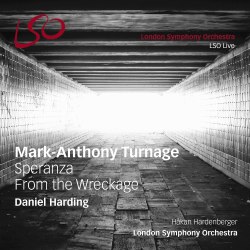|

|
Mark-Anthony TURNAGE (b.1960)
From the Wreckage: Concerto for Trumpet and Orchestra (2004) [15:32]
Speranza (2011-12) [39:45]
Håkan Hardenberger (flugelhorn, trumpet, piccolo trumpet)
London Symphony Orchestra/Daniel Harding
rec. live, February 2013, Barbican, London.
World premiere recording (Speranza)
LSO LIVE SACD LSO0744
[55:37]
From the Wreckage walks a tightrope of atonal angst and quirky jazz-like sounds. Håkan Hardenberger is magisterial as the flugelhorn, trumpet and piccolo trumpet soloist in this richly expressive and phantasmagorical piece. With a crisp and melodious sound, Hardenberger skips across this tightrope as he juggles Turnage’s expression of rage with his own melodiousness. Like a whirling-dervish, the orchestra and trumpet swirl frantically. The music becomes increasingly high-pitched and discombobulated until the final cry and clash drops the curtain on this dizzyingly transfixing performance.
Speranza opens with glistening strings, harmonising flutes and signifying trumpets - that haunt the whole piece - which all cascade into an outcry. Increasingly cogent, Turnage’s latest composition is more mellow and lyrical than his earlier brash, bombastic works. Spliced into four sections entitled Amal [11:55], Hoffen [9.53], Dochas [6.35] and Tikvah [11.22]; Turnage invites us to transcend boundaries and embrace a multiplicity of perspectives.
At some moments, you may feel as though you’ve been battered black and blue by Daniel Harding’s conducting baton, frantically poked and prodded by the sharp-edged string section of the LSO, and partaken in delightful revelry with the xylophonist. However, the scintillating cynosure here is the mournful sound of the Armenian duduk. It’s played exquisitely by Martin Robertson. The duduk mollifies and comforts us whilst adding a pang of longing and sorrow.
Perhaps Speranza is best understood alongside the poetry of Paul Celan, which was the original inspiration for Turnage’s oeuvre. In ‘I Hear’, Celan writes: ‘I hear, the Axe has flowered, / I hear, the Place is un-nameable’. The foregrounded repetition of ‘I hear’ could symbolise the trumpeter’s call whilst a harrowingly listless and Unheimlich feeling pervades both politically and musically in Turnage’s piece.
As a flowering axe with a deep underbelly, Harding uses the holistic nature of the orchestra to evoke Turnage’s cubic inclusivity and allusiveness. His conducting gives Speranza the wide-ranging palette it needs as he allows space for each musician to colour his or her musical phrase with intensity of feeling and purpose. Harding allows the whole orchestra to take part in a conversation, in which - thanks to his omnipresent precision - no one voice mutes or muffles another. This is one of Turnage’s more accessible compositions and is certainly recommended for its sensitivity to the subject and daringness of delivery. After listening to Speranza one can quote Paul Celan and say: ‘I hear, they name Life / our sole Refuge’.
While on the subject of Turnage, I highly recommend Frieze which was performed as part of the BBC Proms, 2013. As a commentary on Beethoven’s Ninth Symphony, it is an interesting composition. Whilst it is quintessentially Turnage, it also serves as an interesting counterpoint to the Beethoven work. It was inspired by the image of mystical figures in a rising procession as seen by Turnage in Gustav Klimt’s ‘Beethoven Frieze’, painted in 1902. Turnage’s Frieze gives voice to a similar sentiment to that of his Speranza symphony where the human desire for happiness contends with a tempestuous world of suffering and internal weakness.
Lucy Jeffery
 |
 |
|
